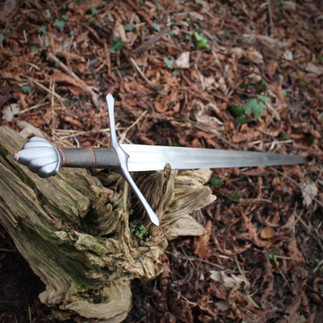The Kilmartin Arming Sword
- Alicia Adams

- Feb 6, 2023
- 3 min read
Updated: Apr 3, 2024

The striking Celtic-meets-Viking aesthetics of this sword are taken straight from the famous gravestone carvings on a gravestone at Kilmartin, believed to have been carved in the late 1300s. It features a gradually tapering blade, downturned quillons with diamond-shaped terminals, and a distinctive five-lobed pommel. It is slightly blade-centric in the hand, with a central pivot keeping it nimble and reactive in cutting and thrusting actions alike. A fantastic all-rounder, this sword would excel paired with a buckler or in its own right as a single-handed weapon. Named for the village that the carvings can be found in, this piece of history-made-real bears a distinct sense of the West Highland warriors of the medieval period. Please see our pricing structure for an idea of what a similar sword would cost.
∴ Specs ∴

Total length: 97cm
Blade length: 80cm
Blade width at shoulder: 4.5cm
Blade stock: 6mm
Quillon span: 22cm
Grip length: 10cm
Grip and pommel: 16cm
Point of balance: 11.5cm
Weight: 1060g
Right-handed
2mm blunt edges
Swollen tip
Fencing flex
∴ Notes ∴

The hand-forged and heat-treated guard and pommel are polished to a satin finish. The downturned crossguard features rounded quillons with flared diamond terminals and a pronounced ecusson. The five-lobed pommel is hollow and canted in a historical fashion for comfortable right-handed use.
The oak grip is wrapped first in linen thread, and then in antiqued brown kidskin. The blade features a wide central fuller and an engraved pearl at the point of balance. The construction is finished with a copper peening block.
∴ Gallery ∴
∴ A Stony Silence∴

The hem of your cloak, wet with evening dew, slaps at your ankles with every step. The mossy grass of the glen, warped with unseen heather, bounces like a soft carpet underfoot. By the dim pre-dusk light the standing stones are like the fingers of a giant, beckoning you onward. The hairs on your neck prickle as you pass them, the way they always did when you walked here as a child.
The stones at your back, you pass through the staggered arch of the kirkyard gate, the screech of a lone owl answering the creak of iron hinges.
Like rows of crooked teeth the graves greet you. You do not pause to mark them. Instead you are drawn, like one who walks in his sleep, to a stone enclosure at the centre of the mist-rimed space. Within it lie seven stones, long and thin and foreboding. You reach out a hand, noticing it shaking, to trace the knots and gnarls carved about their borders.
A great sigh racks your body as you complete your devotion and trail your fingers instead over the swords carved at the centre of each stone. Their blades are broad and gently tapered, their guards bending sharply downward. The petaled pommels blossom like yellow broom, or billow like distant sails.
You draw the sword that hangs at your side, twin to those ensconced in stone, and hold it up before its echoes, clutching the faded brown grip with two hands at your chest. Bowing your head, you imagine your skin growing grey and lichen-covered as you become the effigy they will one day carve for you.
Here you stand, on the cusp of your journey, in the place where your fathers ended theirs. The steam of your breath is a silent prayer in the gathering dark, before you turn with a slap of wet wool and walk away from Kilmartin.





















